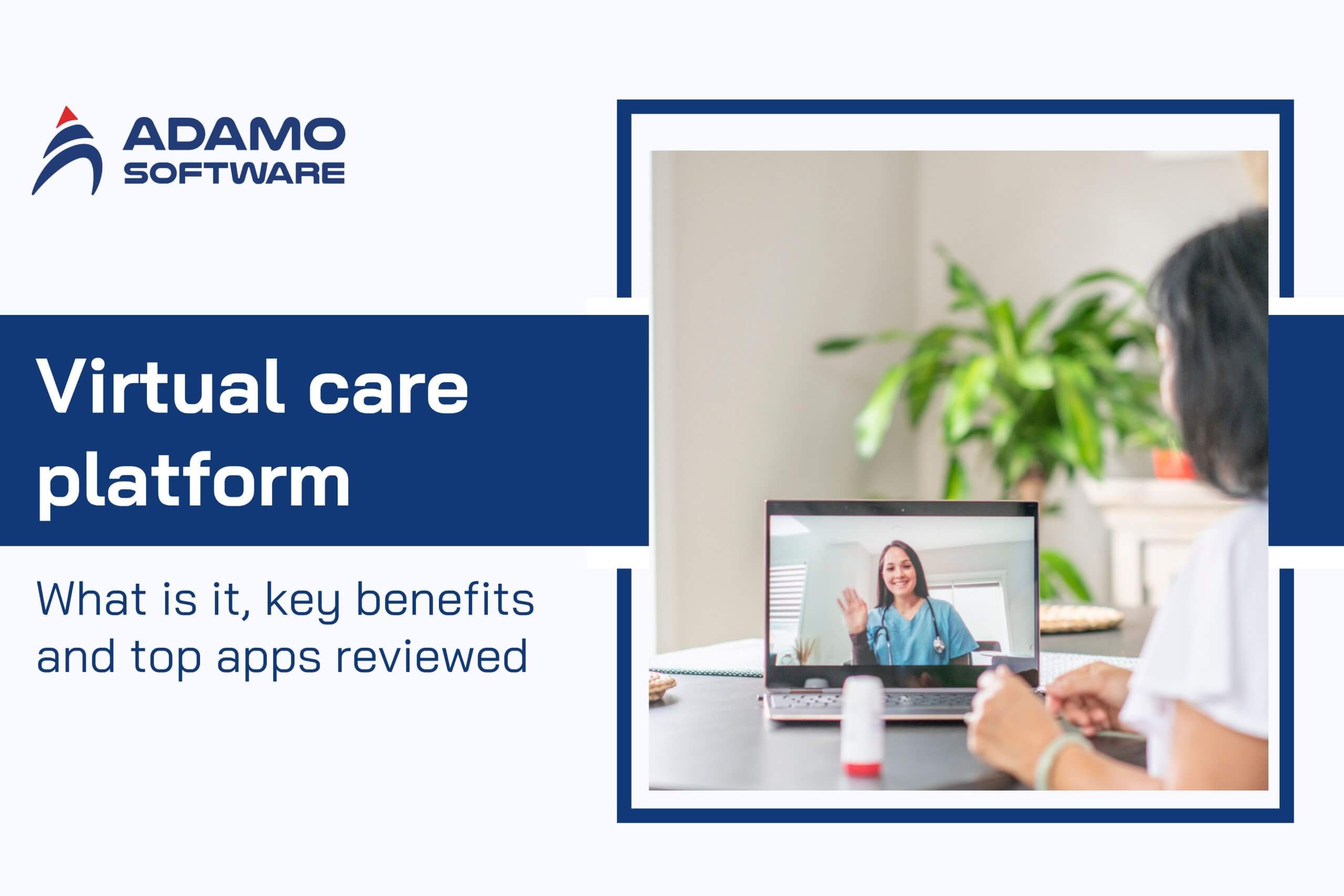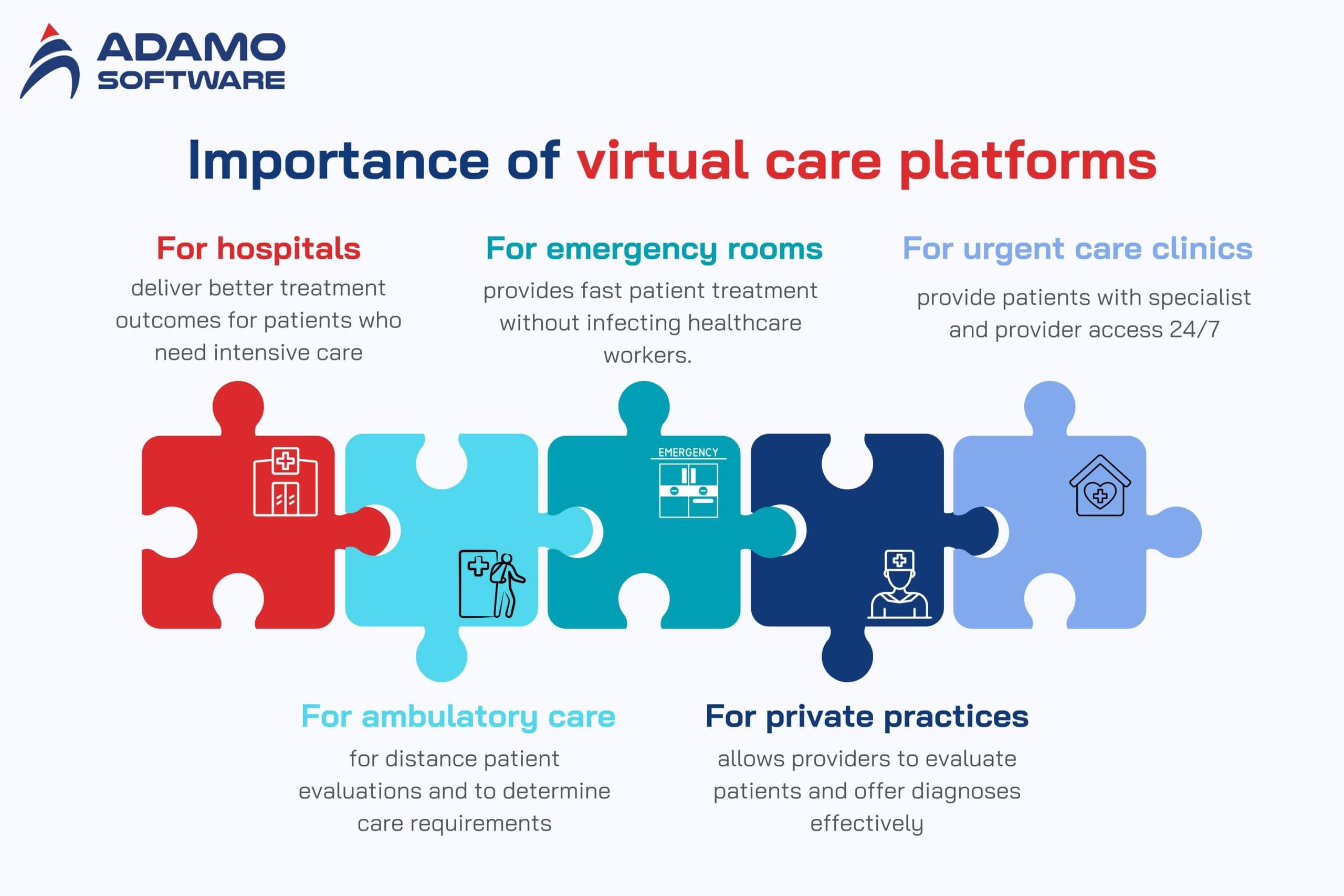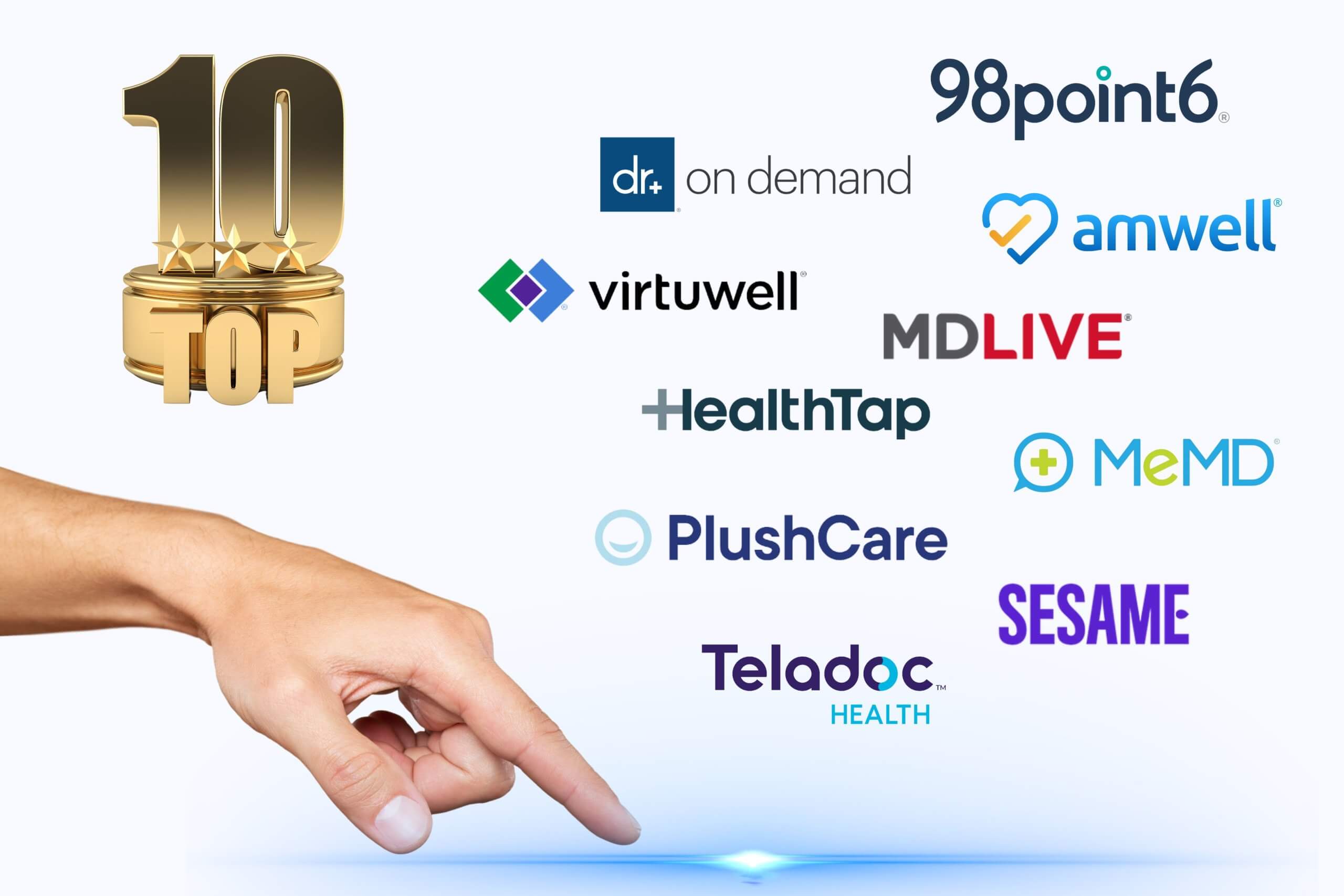Virtual care platform: What is it, key benefits, and top apps reviewed

Looking for a virtual care platform? This article covers key benefits, access to specialists, and reviews of top platforms that are available.
The healthcare environment continues to experience rapid transformation and virtual care platforms function as leading elements in this progress. It’s about time healthcare providers noticed this emerging technology and adopted it to stay ahead of the game. The virtual care platform uses technological methods to provide healthcare services remotely. It does this by creating safe digital connections between healthcare providers and their patients.
Modern life demands immediate service which we can access at any time. The current healthcare system makes patients face long journeys and strict appointment times which hinders their ability to receive rapid care services. A virtual care platform enables patients to handle their health needs through an efficient system that operates within their home environment.
This blog will examine virtual care platform fundamentals together with their multiple advantages for users and medical professionals. The examination will show how these platforms extend healthcare accessibility to advance patient involvement and may reduce healthcare expenses. We will also introduce major virtual care platforms in the current market alongside helpful data to assist you in choosing appropriate healthcare solutions.
Whether you’re a patient seeking convenient care options or a healthcare professional looking to expand your reach, there’s something for everyone. Join us as we uncover the power of the virtual care platform.
I. What is a virtual care platform?
A virtual care platform is a term that is used to describe a kind of telemedicine technology. Virtual care platforms enable clinical staff to reach patients remotely. A video conferencing system operates alongside remote monitoring capabilities through this platform. This gives the system its capabilities for electronic consultations and wireless communication.
The virtual care platform functions on both mobile phones and computers. Additionally, the virtual care platform creates an online scheduling system that assists healthcare providers. Specifically, it delivers better handling of electronic health record (EHR) information.
Accelerated growth has been observed in the virtual care platform market. The pandemic’s social distancing measures expanded the market because people could no longer access safe in-person healthcare services back then.
A total of $21 billion was the worldwide market value for this technology in 2019. Market analysts predict that by 2026, this industry will reach $95 billion globally. The domestic segment of this market may likely exceed $78 billion in value. Health providers benefit from the ability to scale their operations by using virtual care platforms.
II. Virtual care platform, Telehealth, and Telemedicine: Key differences
A virtual care platform refers to the remote collaboration of healthcare providers and patients. The platform serves medical purposes for healthcare assessments and illness treatment in virtual health settings. The concept is different from both telehealth and telemedicine systems.
The term telehealth defines the broad category of all remote medical services. Remote visits, medication delivery, and telepathology methods for skin and urine testing are common examples of the service range of telehealth. The virtual care platform functions within this broad category.
The practice of telemedicine delivers medical treatment to patients without physical encounters. The established diagnosis of chronic illnesses is the main target for this treatment method. In this case, the virtual care platform provides these communication capabilities through telephone and messaging features.
The main objective of virtual health involves implementing remote interactions between healthcare providers and their patients. People connect through mobile applications and software in addition to videoconferencing. Virtual care platforms have been developed to track patient health status through successive check-in procedures.
People need to understand medical service classifications to select appropriate healthcare solutions. A virtual care platform provides patient engagement services and access to non-clinical resources, while telehealth concentrates on clinical care.
III. The importance of virtual care platforms for the healthcare industry

1. For hospitals
Telehealth has shown substantial growth in its usage. Telehealth implementation in hospitals experienced a major increase from 35 percent in 2010 to 76 percent in 2017, according to the American Hospital Association (AHA). Expanding Medicaid telehealth coverage throughout most states enables more patients to benefit from such services.
The COVID-19 pandemic increased the speed of this transformation. Research published by the US Library of Medicine and the National Institutes of Health demonstrates how virtual care software systems transform traditional healthcare practices. According to the study, telemedicine requires adoption as a forward-thinking initiative to boost healthcare delivery instead of serving as an urgent response solution.
The healthcare method offers advantages such as convenience, safety features, scalability, effectiveness, and environmentally friendly practices. Virtual care platforms benefit health services by minimizing emergency room traffic and preserving hospital resources. They also help in decreasing the transmission of COVID-19 when patients receive remote medical attention.
Hospital systems benefit from virtual care platform integration through operational expansion and multiple added values. Through telehealth, hospital facilities can connect with specialists and experts who work outside their physical boundaries. Virtual hospital visits with specialists allow hospitals to decrease the number of patients who require medical attention outside their healthcare institutions.
Hospitals can also use virtual care platforms to deliver better treatment outcomes for patients who need intensive care. Patients benefit from reduced waiting periods because telephysicians provide diagnosis services and initial treatment through virtual capabilities. This faster patient assessment through telehealth leads to superior results and improved patient satisfaction.
Additionally, telehealth enables hospitals to deliver complete patient care services, which leads to improved healthcare results. Hospital staff uses telemedicine to supervise patients throughout their healthcare journey, including diagnostics, home-based recovery, and medication prescription. Hospital virtual care offered at multiple points helps patients regain health more quickly and decreases readmission rates.
2. For emergency rooms
One common problem of emergency rooms is the excessive length of waiting periods for patients. Based on daily factors, patients usually receive treatment after 3 to 4 hours at the facility. Patient health can deteriorate when they wait for treatment, sometimes making them skip medical care altogether.
Hospital emergency departments gain telehealth functionality through the same virtual care platform within the main hospital facility. The solution enables hospitals with restricted funds to deliver remote assessments to patients in busy waiting areas.
Telehealth serves as a pre-entrance implementation in numerous emergency departments to screen patients visiting the ER. Research showed that in-person screening methods had a 25.1% patient abandonment rate, but telemedicine screening reduced this number to 4.5%.
Telemedicine emerged as a vital safety measure for emergency rooms throughout the COVID-19 pandemic. The Center for Health Journalism highlights that telemedicine is crucial for emergency departments. It has succeeded in controlling patient movement through healthcare facilities.
The clinical team treats COVID-19 patients in isolated areas when such care becomes necessary. The patient receives a mask from a nurse or assistant who checks their oxygen levels before being directed toward a private video screening. The provider evaluates patients through video chat to detect COVID-19 and additional health issues. The system quickly isolates urgent cases while performing other exams in tents before sending patients home without doctor interaction.
The telemedicine element of a virtual care platform provides rapid patient care while preventing healthcare provider exposure to infections.
3. For urgent care clinics
Patients find growing appeal in urgent care clinics because these facilities offer rapid, accessible care, which is less expensive. The Urgent Care Association documented an 8% expansion of US urgent care facilities throughout 2017 to 2018. According to the 2018 Benchmarking Report, 70% of patients received an appointment with their provider within 20 minutes. Additionally, 94% were seen within 30 minutes.
The exceptional statistics of these clinics are receiving additional improvement through telemedicine while their operational range continues to increase. The virtual care platforms provide patients with specialist and provider access during weekends, after business hours, and on selected holidays. More patients accessing care enables urgent care clinics to decrease costs and acquire additional market share while boosting revenue.
4. For ambulatory care
Outpatient care facilities, also known as ambulatory care facilities, continue to expand steadily. The facilities offer preventative healthcare services alongside diagnostic imaging and laboratory testing. They also perform same-day surgeries and administer chemotherapy treatments. Additionally, rehabilitation therapy is conducted outside hospital buildings.
Ambulatory care centers can use virtual care platforms for distance patient evaluations and to determine care requirements. They can also work with multiple healthcare professionals and track patient progress post-treatment. Implementing virtual care techniques makes it possible to handle chronic illnesses and disabilities while coordinating patient education and care delivery. Thanks to virtual care platforms, patients can maintain continuous contact with their care providers throughout their home recovery period.
5. For private practices
Private practice physicians who participate in the American Medical Association (AMA) receive strong encouragement to purchase a virtual care platform for telemedicine services. The AMA’s recommendation on telehealth arose from COVID-19. They emphasize that telehealth systems equip medical practices to tackle present and future challenges.
The number of private medical clinics using telemedicine solutions continues to escalate. Under COVID-19 conditions, the AMA projects that 90% of physicians have started using telehealth services. Telehealth enables doctors to provide high-quality, safe care while enhancing patient accessibility, generating new practice revenue streams, and improving patient satisfaction.
Telehealth services currently represent an active patient demand regarding medical care options from their providers. According to an Accenture survey, patients strongly support telehealth because it delivers quality care and results comparable to traditional in-person healthcare visits. After COVID-19 ends, 60% of patients plan to maintain telemedicine usage to handle their health needs and contact medical providers.
Virtual care technology, including videoconferencing and mobile applications, allows providers to evaluate patients and offer diagnoses effectively. They can create personalized treatment plans for medication prescriptions and testing orders while addressing all patient queries. Telemedicine delivered personalized care at better quality standards by patient assessments while patients improved their trust in providers by 60%.
Overall, a virtual care platform allows healthcare providers to establish innovative patient connections for treatment; thus, patients warmly accept this platform. Investing in a scalable solution becomes vital when telehealth advances to become an integral component of healthcare practice. Virtual care platforms present a vast opportunity for healthcare providers to benefit from their adoption.
IV. Top 10 virtual care platforms to consider
Choosing the correct virtual care platform becomes overwhelming due to its increasing popularity. The following list presents the top 10 virtual care platforms that are currently available for selection.
Virtual care platforms provide multiple features that serve a wide scope of medical requirements. Go through our list to identify which solution meets your needs best.

1. Teladoc
One of the first U.S. telehealth companies, Teladoc, originated in Dallas, Texas in 2002. It began as a system that enabled patients to connect with authorized medical doctors anytime for single-session appointments. The company became publicly traded in 2015, which was a major step.
Teladoc obtains most of its revenue from periodic payments made by enrolled patient subscribers. As a healthcare provider, you can enjoy flexible hours and on-demand services.
2. Sesame Care
Sesame Care achieved the position of the top telehealth company in the US according to 2021 rankings. The healthcare reform advocate David Goldhill established the platform in 2019, and the platform experienced 25 times growth during its second year of operation. Sesame implements extended medical appointments while providing healthcare details to patients and increasing doctor compensation by removing intermediary organizations.
3. PlushCare
PlushCare, based in Silicon Valley, provides patients in the US with ongoing healthcare services, urgent care support, online prescriptions, therapy, and mental health solutions. McQuaid established PlushCare through crowdfunding in 2014 after his work as an AT&T mHealth platform lead product manager. Patients can choose between video chat for immediate medical advice or the text system for follow-up questions and phone appointments for alternative communication.
4. MeMD
The Scottsdale-based healthcare provider MeMD delivers medical counseling, behavioral counseling services, and therapeutic advice to patients. The company supports businesses in developing telehealth solutions to reduce healthcare expenses and enable virtual primary care services for company staff. The services can be accessed via both computers and mobile devices.
5. HealthTap
HealthTap started its operations in January 2010 from Mountain View, California. It now establishes itself as the world’s first health practice that provides doctor access to patients using voice, video, and text capabilities. HealthTap has created a platform encouraging worldwide volunteers to distribute health information across all languages while providing medical expertise.
6. MDLIVE
MDLive, founded by Randy Parker in 2009 and based in South Florida, established itself as one of the leading healthcare technology companies. The medical professionals on the platform average ten years of experience. The mobile application from MDLIVE enables users to receive healthcare services throughout the United States at any time.
7. Virtuwell
Virtuwell operates to deliver medical services emphasizing the importance of people combined with experience, health, and stewardship practices. As with other companies listed here, the service works to reduce expenses for people who need health advice.
The medical services at Virtuwell are provided by nurse practitioners with board certifications, leading to cheaper treatment options. The dollar amount for each visit reaches its highest at $59, yet Virtuwell does not impose any costs when it provides the treatment.
8. Amwell
American Well, now Amwell, delivers telehealth solutions to patients and doctors. This platform operates digital health systems that serve government agencies, hospitals, nursing facilities, and private medical offices. Healthcare providers may join Amwell as individual telehealth practitioners or through enrollment in other small to medium independent practice units.
The telehealth satisfaction rating given to Amwell by J.D. Power in 2020 established the platform as a leading firm in digital healthcare services.
9. 98point6
The service at 98point6 serves individuals who need to talk through text messages instead of getting on a webcam with healthcare providers. This medical service provides a text-based platform that allows patients to access discreet care solutions and prescriptions. Additionally, it offers lab testing from qualified medical professionals at all times and in any location.
10. Doctor On Demand
Included Health acquired Doctor On Demand to provide flexible healthcare solutions to providers and patients. Doctor On Demand launched its operations in 2012 as a company co-founded by Dr. Phil McGraw and his son Jay McGraw while providing extensive medical services to patients. Dr. Phil gained his notoriety as a TV star, yet he obtained his doctorate in psychology and remains unlicensed as a psychologist.
V. Why you should partner with Adamo Software for a custom virtual care platform

At Adamo Software, we focus on developing tailor-made virtual care platforms that redesign healthcare service delivery. Through our telemedicine solutions providers can establish virtual consultations which provide healthcare access to patients in all locations at any time.
Working with us provides you with direct access to our capability to build secure interfaces along with HIPAA-compliant systems while offering a user-friendly design. The key features of our process allow platform evolution through user feedback, which results in better functionality and improved audience engagement.
Our services use AI and IoT to enhance patient monitoring systems while delivering better health results. Select Adamo Software to boost your virtual care system while delivering outstanding healthcare solution interactions to patients. Contact us now!











